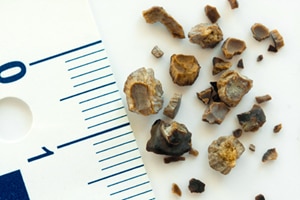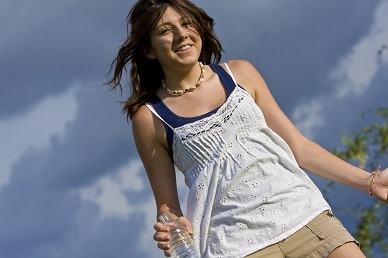Treatment & Prevention for Kidney Stones in Children
How do health care professionals treat kidney stones in children?
Health care professionals usually treat kidney stones based on their size, location, and type.
Small kidney stones may pass through the urinary tract without treatment. Children may need to urinate through a strainer for a few days to catch the kidney stone in a special container. A health care professional will send the kidney stone to a lab to find out what type it is. Children need to drink plenty of liquid to help move a kidney stone along. A health care professional may also prescribe pain medicine.
Larger kidney stones, or kidney stones that block a child’s urinary tract or cause great pain, may need urgent treatment. A child who is vomiting and dehydrated, may need to go to a hospital and get fluids through an IV.

Kidney stone removal
A urologist can remove the kidney stone or break it into small pieces with the following treatments:
Shock wave lithotripsy. Shock wave lithotripsy works from outside a child’s body to blast the kidney stone into small pieces. The smaller pieces of the kidney stone then pass through the urinary tract. A health care professional gives anesthesia during this outpatient procedure to prevent pain or help a child keep still.
Cystoscopy and ureteroscopy. During cystoscopy, a health care professional uses a thin tube with a tiny lens at one end to look inside the urethra and bladder to find a stone. During ureteroscopy, a longer and thinner instrument is used to see the lining of the ureters and kidneys.
In both procedures, the health care professional inserts the scope through the urethra to see the rest of the urinary tract. Once the stone is found, it can be removed or broken into smaller pieces. The health care professional performs these procedures in the hospital with anesthesia. A child can typically go home the same day.
Percutaneous nephrolithotomy. A thin viewing tool, called a nephroscope, is used to locate and remove the kidney stone. A health care professional inserts the tool directly into the kidney through a small cut made in the back. For larger kidney stones, a laser may be used to break the kidney stones into smaller pieces. A health care professional performs percutaneous nephrolithotomy in a hospital with anesthesia. Recovery usually takes several days in the hospital.
After these procedures, sometimes the urologist leaves a thin flexible tube, called a ureteral stent, in the urinary tract to help urine flow or a stone to pass. Once the kidney stone is removed, it’s sent to a lab to find out what type it is.
After a kidney stone has passed or been removed, a child may need to collect urine for 24 hours. The goal is to measure how much urine is produced in a day, along with mineral levels in the urine. A child is more likely to form stones again if he or she doesn’t make enough urine each day or has high mineral levels.
How can kidney stones in children be prevented?
To help prevent future kidney stones, learn what caused a child’s previous kidney stones. With that information, a health care professional can suggest changes in the child’s eating and drinking habits to prevent future kidney stones.
Drinking liquid
Drinking enough liquid each day is the most important lifestyle habit to help prevent kidney stones. Drinking enough liquid keeps urine diluted and helps flush away minerals that might form stones. Urine should be almost clear if a child is drinking enough water.
A teenager should drink six to eight 8-ounce glasses a day, unless he or she has kidney failure. A teenager who’s had cystine stones may need to drink even more. Younger children can follow their health care professional’s guidance about how much liquid to drink. Talk with a health care professional if a child can’t drink the recommended amount due to other health problems, such as urinary incontinence, urinary frequency, or kidney failure.
The amount of liquid needed also depends on a child's activity level. Children and teenagers who live and exercise in hot weather may need more liquid to replace the fluid lost through sweat. A child may be asked to collect urine over 24 hours to measure the amount produced in a day. If the amount of urine is too low, he or she may need to drink more liquid.
Though water is best, other liquids such as citrus drinks may also help prevent kidney stones. Lemon and lime juice contain very high levels of citrate, which stops crystals from clumping together to form kidney stones. Choose citrus drinks that are low in sugar to avoid taking in excess calories, which can be unhealthy.

Medicines
After a child has one kidney stone, a health care professional may prescribe medicines to prevent future kidney stones. The medicine may be needed for a few weeks, several months, or longer, depending on what caused the first kidney stone.
For example, for struvite stones, a child may take an antibiotic by mouth for 1 to 6 weeks, or possibly longer. Treatment of an abnormally shaped urinary tract may also be suggested to prevent future struvite stones.
For other types of stones, a health care professional may prescribe a potassium citrate tablet 1 to 3 times daily. A child may continue to take potassium citrate for months or longer, until the risk for kidney stones in gone.
| Type of kidney stone | Possible medicines prescribed |
|---|---|
| Calcium Stones |
|
| Uric Acid Stones |
|
| Struvite Stones |
|
| Cystine Stones |
|
Talk with a health care professional about a child’s health history before he or she takes kidney stone medicines. Some kidney stone medicines have minor to serious side effects. Side effects are more likely to occur the longer a child takes the medicine and the higher the dose. Tell the child’s health care professional about any side effects that occur with kidney stone medicine.
This content is provided as a service of the National Institute of Diabetes and Digestive and Kidney Diseases
(NIDDK), part of the National Institutes of Health. NIDDK translates and disseminates research findings to increase knowledge and understanding about health and disease among patients, health professionals, and the public. Content produced by NIDDK is carefully reviewed by NIDDK scientists and other experts.
The NIDDK would like to thank:
Michael J.G. Somers, MD; Harvard Medical School; Michelle A. Baum, MD, Harvard Medical School; Jeffrey M. Saland, MD, MSCR, Icahn School of Medicine at Mt. Sinai

